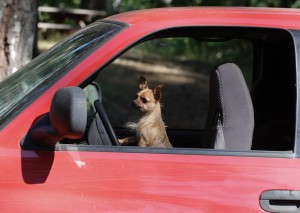 A woman left her dog in a crate in her car while she went into a store. A drunk drove into her car, breaking open the crate and smashing out the window. The woman returned to find her dog missing.
A woman left her dog in a crate in her car while she went into a store. A drunk drove into her car, breaking open the crate and smashing out the window. The woman returned to find her dog missing.
She posted about the missing dog in many places, and the vast majority—not one or two, but most—of the responses suggested that it was her fault for having her dog in a car. That her dog was better off dead, roaming the streets, or finding any other home, than it was continuing to live with someone who would treat it so inhumanely as to leave it in a car.
This should send a chill down the spine of every informed animal lover: not only is it absolutely insane, it is a tangible demonstration of how devastatingly effective the animal rights movement has already been in making it socially unacceptable for anyone to have a dog:
They started with a reasonable assertion: cars can get dangerously hot if left in the sun, and anyone leaving a dog in a car needs to be aware of the temperature and take appropriate precautions to ensure their dog is safe and comfortable. Of course, everyone agreed! They began passing laws mandating that dogs were not left in hot cars, and while a few wise individuals foresaw the risk in such statutes, most people cheered and voted yes. Then they began lowering the recommended temperature until almost any day was ostensibly too hot for a dog to be in a car. Then they suggested that cold cars could be a problem. Then they suggested that dogs needed to be restrained in crates when in cars. Then they suggested that dogs should never be stuck in crates because it is inhumane.
BAM!
There you have it—dogs should not be in cars! Not ever. It is un-natural, unsafe, inhumane.
Of course that it is absolutely untrue: Most dogs love going places, love hanging-out in the car. Love the awesome adventures and enriching fun in which they get to participate by going in the car. Even if this means they have to nap in the car while mom runs some errands. Most dogs, given a choice, will get in the car and go almost every time. Most dogs spend a huge portion of their time lounging about anyway, and doing it in the car is as good as anywhere, and if it means they get to go for a swim or a hike or even just hang with their mom all day, it is even better. Most cars can be kept at a safe temperature on most days with a modicum of effort.
Yes, this means that a teeny-tiny percentage of dogs will die in car accidents or overheated cars or whatever. So will some people. Animals die every day out in the natural world, because life has risks. We must constantly be wary of invoking regulations that would save a few animals or people from harm by grossly diminishing the lives of millions.
It is stupefying that they believe dogs should not be in cars. But what is truly scary is how easily most well-meaning animal lovers have been convinced to accept this propaganda.
For many years, pet lovers have shrugged their shoulders about the animal rights movement—sure, they are perfidious loons, but they are no real threat. They may outlaw exotic species, or chickens or cows, but surely they would stand no chance if they came after dogs and cats.
WAKE UP! They are going to eliminate pets without ever having to say a word about it: They are simply going to make it socially unacceptable to have pets in cars, in crates, or on collars. It will be stigmatized to take your dog with you, or to leave your dog home alone. To feed your dog unnatural kibble, or to feed your dog dangerous raw food. To own multiple dogs which means you do not have enough time for each, or to own a single dog who should not be forced to live a lonely life without canine companions. Nobody should have a dog that does not have a CGC. Nobody should have a dog of certain breeds. No dog should live in a home that is not air conditioned and heated. Nobody should ever have an intact dog. Nobody should breed a dog.
These are not the paranoid imaginings of a conspiracy theorist. Oh, how I wish they were! But every single one of these things has already been stated, many have already been legislated, and most importantly, they are, with alarming rapidity, becoming accepted social norms.
Well-meaning pet lovers show up in droves to support bills and regulations that seem designed to make life better for pets, without recognizing that these bills are quickly making it impossible for anyone to keep dogs in any manner without being vilified.
Make no mistake about it, pet ownership is under serious and immediate attack, and it is up to those of us who truly love animals to protect it.
